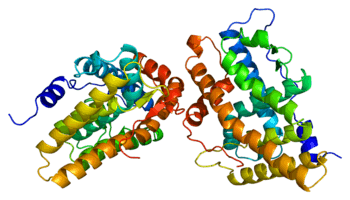Aromatase deficiency
| Aromatase deficiency | |
|---|---|
|
AES results when the function of aromatase is impaired. The aromatase protein (pictured) is required for the biosynthesis of estrogens like estradiol in the human body. | |
| Classification and external resources | |
| Specialty | Endocrinology |
| OMIM | 107910 |
| DiseasesDB | 29906 |
Aromatase deficiency is a condition resulting from insufficient production of the enzyme aromatase,[1] which can result in inappropriate virilization of female fetuses and delayed puberty, as well as inappropriate virilization of the mother during pregnancy.
Signs and symptoms
The deficiency causes the virilization of XX fetuses. Although they will have normal female internal genitalia, clitoromegaly often results from the high androgen levels in utero, along with ambiguous external genitalia upon birth.
Testosterone may be normal or elevated.[2]
Later, the lack of estrogen results in the presentation of primary amenorrhea and tall stature. The taller than expected height occurs because estrogen normally causes fusion of the epiphyseal growth plates in the bones, and in its absence, the girl will keep growing longer. The gonadotropins LH and FSH will both be elevated and patients present with polycystic ovaries. Furthermore, the low estrogen will predispose those with the condition to osteoporosis.
In pregnancy
Aromatase deficiency in the baby can also affect the mother during gestation, with cystic acne, hirsutism, deepening of the voice, and clitoromegaly. Increased circulating testosterone levels are the cause. The mother's symptoms resolve after she gives birth.[3]
Cause
During pregnancy, the placenta, which is fetal tissue, synthesizes large amounts of estrogen. The levels of estrogen in the mother can elevate 100-fold higher than normal cycling levels. In fetal aromatase deficiency, the placenta synthesizes the intermediates in the biosynthesis of the estrogens, androstenedione and testosterone, but cannot convert them the rest of the way due to the absence of aromatase. These compounds, which are androgens, subsequently accumulate to high levels and circulate, severely masculinizing both the fetus and the mother. The mother will experience cystic acne, hirsutism, deepening of the voice, and clitoromegaly, which will partially reverse following parturition. The fetus, if female, will be born with severely masculinized external genitalia, including labioscrotal fusion and a greatly enlarged phallus. A male fetus will be born with normal genitalia.[4]
At puberty, due to the lack of aromatase, estrogens will not be synthesized by the ovaries, and normal puberty, including breast development and the onset of menses, will not occur. Instead, androgens will elevate once again above normal levels, and may cause additional virilization, such as acne, hirsutism, and further enlargement of the clitoris, unless treatment with estrogen is given.[4]
See also
- Estrogen insensitivity syndrome
- Aromatase excess syndrome
- Congenital estrogen deficiency
- Inborn errors of steroid metabolism
- Disorders of sexual development
References
- ↑ Morishima A, Grumbach MM, Simpson ER, Fisher C, Qin K (December 1995). "Aromatase deficiency in male and female siblings caused by a novel mutation and the physiological role of estrogens". J. Clin. Endocrinol. Metab. 80 (12): 3689–98. doi:10.1210/jc.80.12.3689. PMID 8530621.
- ↑ Zirilli L, Rochira V, Diazzi C, Caffagni G, Carani C (April 2008). "Human models of aromatase deficiency". J. Steroid Biochem. Mol. Biol. 109 (3-5): 212–8. doi:10.1016/j.jsbmb.2008.03.026. PMID 18448329.
- ↑ Jones ME, Boon WC, McInnes K, Maffei L, Carani C, Simpson ER (May 2007). "Recognizing rare disorders: aromatase deficiency". Nat Clin Pract Endocrinol Metab. 3 (5): 414–21. doi:10.1038/ncpendmet0477. PMID 17452968.
- 1 2 Bulun, Serdar E. (2014). "Aromatase and estrogen receptor α deficiency". Fertility and Sterility. 101 (2): 323–329. doi:10.1016/j.fertnstert.2013.12.022. ISSN 0015-0282.
